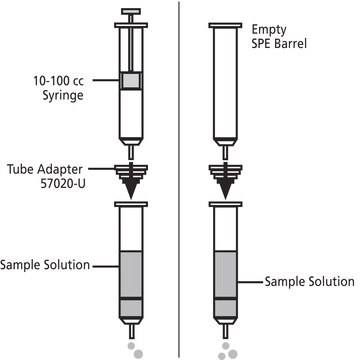55508-U
Discovery® Glycan SPE Bulk Packing
pkg of 50 g
Sign Into View Organizational & Contract Pricing
All Photos(1)
About This Item
UNSPSC Code:
41115712
NACRES:
NB.21
Recommended Products
packaging
pkg of 50 g
Quality Level
technique(s)
solid phase extraction (SPE): suitable
impurities
<5% Water content
matrix
polyamide resin base material
matrix active group
amide, poly- phase
particle size
50-160 μm
pH range
4.5-7.5(surface pH)
bulk density
0.2‑0.3 g/mL
separation technique
reversed phase
Related Categories
General description
Retention Mechanism: Reversed-phase
Sample Matrix Compatibility: Aqueous or methanolic solutions
Sample Matrix Compatibility: Aqueous or methanolic solutions
- Polyamide Resin: Particle Size: 50-160 μm, Surf pH: 4.5-7.5, Density: 0.2-0.3 cm3/g, Water Content: < 5 %
- Useful for extracting gylcans from aqueous solutions.
- Used to adsorb polar compounds (-OH groups, esp. phenolic compounds) from aqueous or methanolic solutions under the reversed-phase mechanism through strong hydrogen bonding between compound hydroxyl groups and amide groups of the resin
- Also may be used for the extraction of tannins, chlorophyll, humic acid, pharmacologically active terpenoids, flavanoids, gallic acid, catechol A, protocatechuic acid, phloroglucinol, aromatic carboxylic acids, and nitroaromatic compounds
- Irreversibly retains quinones.
Legal Information
Discovery is a registered trademark of Merck KGaA, Darmstadt, Germany
Storage Class Code
11 - Combustible Solids
WGK
WGK 3
Flash Point(F)
Not applicable
Flash Point(C)
Not applicable
Choose from one of the most recent versions:
Already Own This Product?
Find documentation for the products that you have recently purchased in the Document Library.
Jarod A Zepp et al.
Journal of immunology (Baltimore, Md. : 1950), 199(11), 3849-3857 (2017-10-27)
This study identifies a novel mechanism linking IL-17A with colon tissue repair and tumor development. Abrogation of IL-17A signaling in mice attenuated tissue repair of dextran sulfate sodium (DSS)-induced damage in colon epithelium and markedly reduced tumor development in an
Heng Liang Tan et al.
Scientific reports, 8(1), 11608-11608 (2018-08-04)
Monoclonal antibodies (mAbs) are used as targeted therapies against cancers. These mAbs kill cancer cells via various mechanisms of actions. In this study, human embryonic stem cells (hESCs) was used as the immunogen to generate a panel of antibodies. From
Haley Shelley et al.
AAPS PharmSciTech, 19(6), 2554-2563 (2018-06-28)
Nepafenac is a nonsteroidal anti-inflammatory drug (NSAID), currently only available as 0.1% ophthalmic suspension (Nevanac®). This study utilized hydroxypropyl-β-cyclodextrin (HPBCD) to increase the water solubility and trans-corneal permeation of nepafenac. The nepafenac-HPBCD complexation in the liquid and solid states were
Chiara Setti et al.
European journal of pharmaceutics and biopharmaceutics : official journal of Arbeitsgemeinschaft fur Pharmazeutische Verfahrenstechnik e.V, 130, 71-82 (2018-06-22)
Emulsions are known to be effective carriers of hydrophobic drugs, and particularly injectable emulsions have been successfully implemented for in vivo controlled drug release. Recently, high internal phase emulsions have also been used to produce porous polymeric templates for pharmaceutical
Hsin-Yuan Chen et al.
Cellular physiology and biochemistry : international journal of experimental cellular physiology, biochemistry, and pharmacology, 49(5), 1970-1986 (2018-09-21)
Uterine leiomyomas (ULs) are benign uterine tumors, and the most notable pathophysiologic feature of ULs is excessive accumulation of extracellular matrix (ECM). Fucoidan is a polysaccharide extracted from brown seaweeds that has a wide range of pharmacological properties, including anti-fibrotic
Articles
Reversed-phase interaction will retain most molecules with hydrophobic character; it is very useful for extracting analytes that are very diverse in structure within the same sample.
Our team of scientists has experience in all areas of research including Life Science, Material Science, Chemical Synthesis, Chromatography, Analytical and many others.
Contact Technical Service



